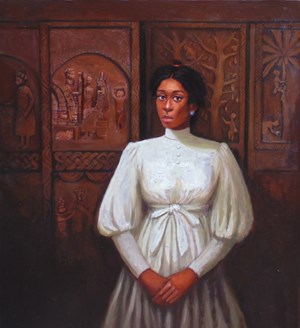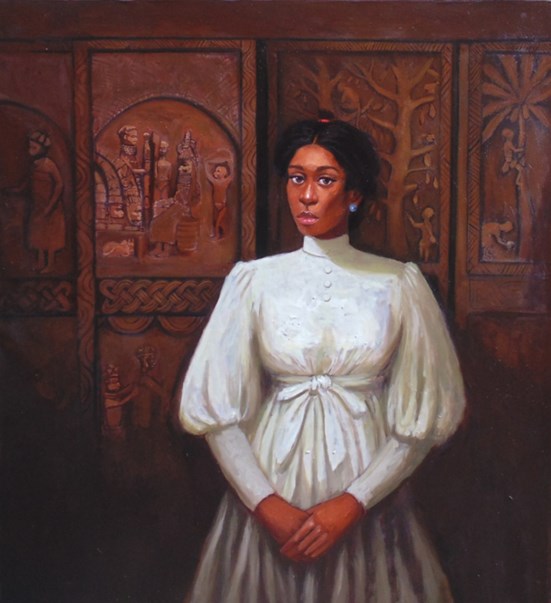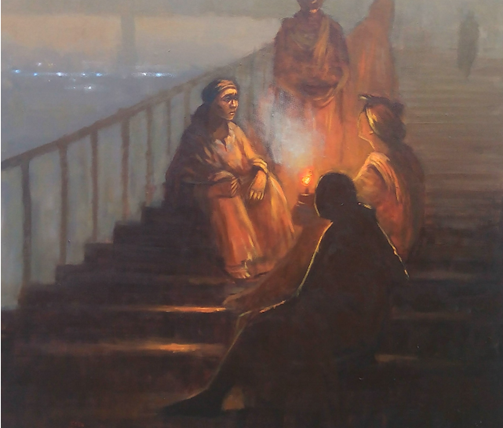
Tega Akpokona is one of Nigeria’s young emerging artists. He graduated in 2011 with a BA in Fine and Applied Arts from the University of Benin, where he specialised in painting. After graduation, Akpokona received mentorship from one of Nigeria’s acclaimed artist, Abiodun Olaku. His practice builds on the techniques of the European masters and shares their preoccupation with the effects of light and colour.
Image: Tega Akpokona Uwa, 2019
Tega Akpokona is one of Nigeria’s young emerging artists. He graduated in 2011 with a BA in Fine and Applied Arts from the University of Benin, where he specialised in painting. After graduation, Akpokona received mentorship from one of Nigeria’s acclaimed artist, Abiodun Olaku. His practice builds on the techniques of the European masters and shares their preoccupation with the effects of light and colour.
He uses these techniques to create stunning works with themes revealing deep human emotions and depict scenes of daily life. His work also reflects on issues in his immediate locale such as socio-economic matters and the everyday realities of living in Nigeria, all of which he renders in rich layers of oil paint on canvas. Akpokona’s work is in significant private collections in Nigeria and abroad. He held his first solo exhibition, Timeless, in 2016 at Terra Kulture in Lagos, Nigeria, and was among the artists selected for Tafeta’s summer 2018 exhibition.
Akpokona will be featuring for the second year consecutively, at ART X Lagos.
ArtDependence (AD): Can you tell us about your work process?
Tega Akpokona (TA): My work process is a lot more abstract than what it looks like when it's finished. I'm very particular about design. I paint mostly in oil color (on canvas, copper, paper, board), which is a slow drying medium, so there's a lot of room for an extensive thought process and contemplation while the painting is going on, which allows me to pour in as much emotional content into the work as I possibly can.
AD: What are some of the themes you are drawn to explore and how is this reflected in your works?
TA: The prevalent feature in all themes I explore in my work is light and how it interacts with human existence. The portrait and figure will always be a reoccurring theme for me.
I'm also inspired by the industry of artisans and craftsmen like the blacksmiths and seamstresses which have been a feature in my works over time

Tega Akpokona Uwa, 2019
AD: How did you first get interested in figurative paintings?
TA: I'll say it started with the compulsion to draw or sketch people from an early age. From sketching classmates to siblings and random strangers who were not particularly posing for me, of course at that point it wasn't about figurative art it was more about interpreting what I saw the best way I could and doing something that brought me so much satisfaction. All of which served as a background of much needed practice later when I started learning about painting.
AD: Your paintings are reminiscent of the distinct and delicate rendition of the Renaissance times. How were you inspired to portray your subjects in this style?
TA: As much as I am inspired by the phenomenal works of artists from the renaissance period, I'm greatly inspired by the generations of great masters afterwards. I'm constantly in awe of the works of artists from the Dutch Baroque period; Rembrandt, Caravaggio, Reubens, Vermeer and a lot of other great artists. I'm fascinated by the way they told their stories. From the theatrical lighting, dramatic movement of forms, to the depth of emotions they conveyed through paint. So, in the process of telling my stories, it was only natural to drift towards the direction of the art I love.
AD: How has your idea of creating work evolved over the years of your practice? How do you see it evolving in the future? Is the renaissance effect one you see yourself pursuing for a while such that it will always remain your trademark?
TA: The future will always be a blank canvas. What's most important to me is consistency and the pursuit of art that transcend time. As much as we've evolved as human beings over time, human emotions remain the same. To capture the depth of human emotions, and telling our story of Africans and why we are so extraordinary as a people will always be an important part of my work.
AD: How do you achieve the distinct light effect encountered in your paintings? Do all your works carry a calm hue?
TA: I try my best to observe with the intent of having an understanding of the nature of light itself. Light is tangible and is the reason we can appreciate colour, and only by keen observation can you understand how light interacts with surfaces and atmosphere. Once you can understand that, transforming paint pigments into light rays becomes a matter of consistent practice.

Tega Akpokona, Askers at the Foot of the Bridge, 2015
The calm hue has become a constant feature in most of my paintings. Art has a unique way of exposing your temperament.
AD: What are some of the reactions you hope the works in the exhibition will evoke in those who encounter them?
TA: I prefer to keep an open mind when it comes to expectations from the people who view my work. I only hope my work stimulates a genuine and unforgettable emotional experience in the mind of the viewer.
AD: Do you plan your paintings with sketches or drawings?
TA: As much I try to plan my works with sketches on paper, the paintings usually end up taking a different direction altogether. I do sketch my ideas most times in abstraction. What's most important is to establish the general concept and design.
AD: Do you always know the subjects in your works or they are sometimes imagined?
TA: It's a combination of both. I like to paint from life, so I can have people model for me in my studio. But a lot of times I imagine people. I like the process of remembering, combining and recreating human features and the satisfaction that comes with creating an entirely new character.
AD: Who and what are some of your biggest influences?
TA: Among my first defining influences in my artistic pursuit is the Universal Studios of Art, Lagos, one of Nigeria's biggest ateliers, where I was an industrial trainee as a student, and also a graduate intern years after, under the mentorship of master artist Abiodun Olaku.
AD: What do you do when you are not creating work of art?
TA: I engage in other activities like listening to a lot of music. I read. I enjoy coffee. Pray and meditate. I take long beach walks. I do martial arts. I spend a lot of time enjoying the works of other creative minds, both past and living. And do all the other important things to create a happy life.

ArtDependence Magazine is an international magazine covering all spheres of contemporary art, as well as modern and classical art.
ArtDependence features the latest art news, highlighting interviews with today’s most influential artists, galleries, curators, collectors, fair directors and individuals at the axis of the arts.
The magazine also covers series of articles and reviews on critical art events, new publications and other foremost happenings in the art world.
If you would like to submit events or editorial content to ArtDependence Magazine, please feel free to reach the magazine via the contact page.